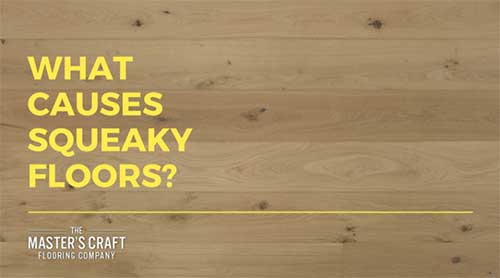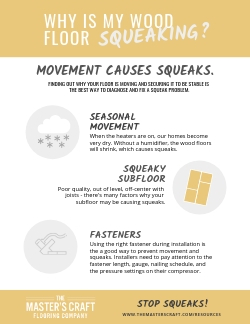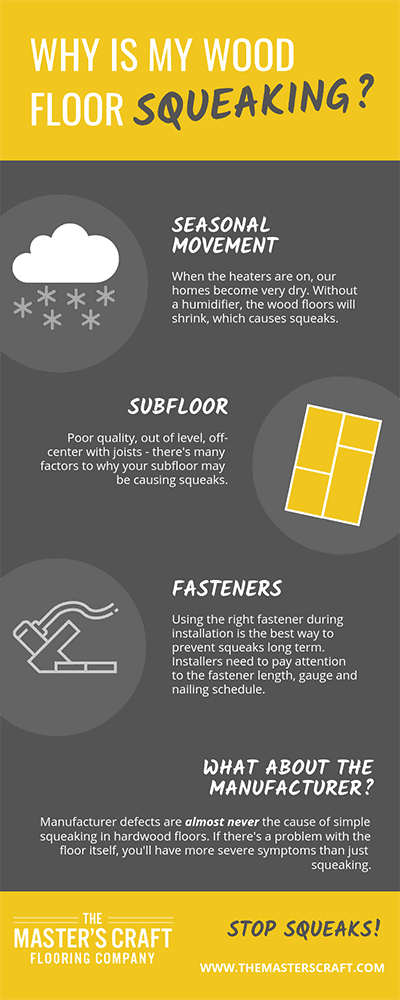Squeaky Subfloor Issues
An improperly installed subfloor is one of the most common reasons for squeaky floors. If the subfloor itself is squeaky, no flooring product will cover up those noises.
Subfloor issues are often one of the following:
- Out of level subfloor
- Spacing between the subfloor and joists
- Subfloor seams off center with joists
- Too high quality subfloor
Out of level subfloor
An out of level subfloor has many causes. The essence here is that an out of level subfloor creates the presence of voids between the subfloor and the flooring.
Any size of void allows the possibility of movement, creating squeaks and creaks.
Remember: to completely avoid squeaky floors, you must eliminate all movement that affects the wood floor.
Eliminate voids in the subfloor and you’ll eliminate movement and squeaks.
Where can you find voids in your subfloor?
- Residue on the subfloor. Construction residue on the subfloor (drywall mud, adhesive, unseated fasteners, etc.). Install the flooring over this residue and part of your floor will be suspended in air. Bring on the squeaks!
- High/low areas in the subfloor seams. (Good wood flooring installers will sand the seams of plywood flat). If the subfloor isn’t perfectly flat, parts of the flooring are suspended in air.
- Joists out of level.
- Settling in the home.
- Heaving beams.
Spacing between the subfloor and joists
As we just talked about, any void between the wood flooring and the subfloor can allow for movement.
Any void between the subfloor and the joists can also allow for movement. Realistically, many factors cause voids between subfloor and joists.
However, there’s really only one way to prevent voids: to glue AND nail the subfloor to joists – and to do it carefully.
Unfortunately, this isn’t as common a practice as the flooring professional would like.
Most contractors only nail the subfloor down. Often, the nails miss joists which means that the flooring is not permanently attached. In addition, the nails also miss the voids between the joists and subfloor.
By gluing AND nailing the subfloor, all possible voids between subfloor and joists can be eliminated.
Subfloor seams off center of joists
Hopefully this is an incredibly rare occurrence, but in a rush, a contractor might install a subfloor off center of the joists. This means that seams of flooring are over a void. Nothing solid is resisting the movement of the flooring and subfloor – causing squeaks anytime someone walks on this area.
Poor quality subfloor or degraded subfloor
Subfloors come in varying grades, and experience different elements along the construction stages.
A low-quality subfloor or one that was subjected to rain and/or flooding will be degraded (no matter what the salesman said about it being waterproof). Waterlogged wood chips glued into sheets will not hold fasteners like higher quality plywood that was carefully kept dry.
Too high quality subfloor
Now this one might get folks riled up.
Is it possible to have a too high quality OSB?
In reality, the use of the word “quality” was probably not accurate, but I thought it would get your attention.
Some of the OSB’s today have a resin content so high that the subfloor can be too hard. This makes the product too brittle. Fasteners barely penetrate and once through, the material is too rigid to maintain a hold.
Imagine nailing through sheet metal. The nail might hold for a little while, but once broken loose, the nail’s not just moving – it’s also screaming at you like nails on a chalkboard.
Your Fastener May Be Causing Squeaks
The best way to prevent squeaks: install the floor correctly. Over seating of fasteners and using the wrong fastener or frequency are the most common installation problems that lead to squeaks.
Over seating of fasteners
This is a very common cause of squeaks. When a fastener is over seated into a wood floor, wood material is pushed out of the bottom of the wood floor raising the overall floor into the air (even ever so slightly).
Like we talked about previously, wherever there is a void between the flooring and the subfloor, there is possibility for movement, and squeaks.
Inadequate fastener size or fastener frequency
Very small fasteners will not hold the flooring in the subfloor adequately. They’ll have a minor hold which can be loosened over time.
The stress of daily walking on the floor can cause these small fasteners to loosen and squeak within the subfloor.
This goes the same for inadequate numbers of fasteners – the smaller the hold, the more likely they’ll be loosened and squeak.
We’ve put together a video and article that explains the importance of proper fastener use and how to make sure that you’re using the right now. Learn more about it here.
What’s missing from this list?
You may have noticed one particularly commonly held view is absent from this list: “Manufacturer defect.”
This is because manufacturer defect is almost never the cause of simple squeaking in hardwood floors.
Squeaky floors could be the symptom of a much deeper defect, but the squeak is not the only symptom.
The following are commonly held, but mistaken, beliefs about manufactured caused squeaks:
Loose Tongue and Groove
Manufacturers mill the tongue and groove of flooring to fit flooring together easily. Our goal: allow for blind nailing of flooring and easy installation.
The tongue and groove are designed to fit together somewhat snugly while allowing for enough room to be fit together by hand. While the flooring is being manufactured, this is being tested constantly.
We must remember that as soon as the moisture content of the flooring changes, the fit of the tongue and groove will change.
If the flooring becomes drier, the tongue and groove will be looser. When the flooring grows in moisture content, the fit becomes snugger.
The manufacturer cannot guarantee the fit of the tongue and groove in every installation environment.
At the end of the day, it is the installer’s responsibility to ensure that the fit of the tongue and groove is appropriate at the time of installation.
Hearing squeaking out of the box? Then the manufacturer should be contacted.
Squeaking 24 hours after installation? You can be assured the cause is something other than manufacturing. If it was manufacturer related, it would squeak out of the box.
Delamination
Engineered hardwood flooring rarely delaminates.
The typical cause of flooring separation is extremely dry conditions that tear the flooring apart. However, when there is delamination, squeaks are a symptom of an underlying and more severe problem.
Boards raise up, curl and no longer stay flat. In this case, the squeaks aren’t usually mentioned because the other issues are too severe.
So, how can I stop my floor from squeaking?
As you can see, squeaking floors can be a frustrating puzzle to solve.
But it comes down to some basics. First, that movement is always the primary cause. From there, eliminating movement is the only solution.
Once this is understood, decisions can be made to remedy the creaks and noise.
Here are some possible solutions for squeaky floors:
- Squeak No More: http://www.oberry-enterprises.com/ This method will allow for top screwing boards, but counter sinking the screws.
- Lubricants: This may sound a little hokey, but talcum powder, graphite and WD-40 are all solutions that have helped squeaky floors. This is usually somewhat temporary. One NWFA certified inspector we know swears by WD-40 as a solution. In these cases, the movement is causing friction between the flooring boards. When this is the case, lubricating the friction points will eliminate the sound.
- Screws from underneath to seat the flooring to the subfloor in problem areas.
- Squeak Ender: http://www.squeakender.com/ This cures the issue of voids between subfloor and flooring joists. Shimming the voids can also help here, but might cause squeaks in other areas
- Hollow spot repair: drilling a hole in the flooring and filling the void with epoxy is a possible solution: http://www.dritac.com/productsRS.php




